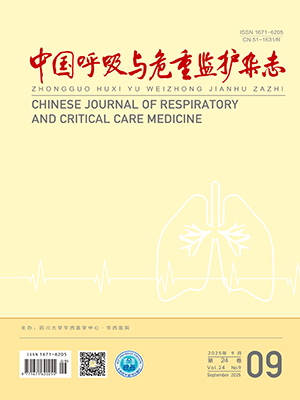Objective To investigate the antibiotic resistance distribution and profiles of multidrug resistant bacteria in respiratory intensive care unit ( RICU) , and to analyze the related risk factors for multidrug resistant bacterial infections. Methods Pathogens from79 patients in RICU from April 2008 to May 2009 were analyzed retrospectively. Meanwhile the risk factors were analyzed by multi-factor logistic analysis among three groups of patients with non-multidrug, multidrug and pandrug-resistant bacterial
infection. Results The top three in 129 isolated pathogenic bacteria were Pseudomonas aeruginosa ( 24. 0% ) , Staphylococcus aureus( 22. 5% ) , and Acinetobacter baumannii( 15. 5% ) . The top three in 76 isolated multidrug-resistant bacteria were Staphylococcus aureus ( 38. 9% ) , Pseudomonas aeruginosa ( 25. 0% ) , and Acinetobacter baumannii( 19. 4% ) . And the two main strains in 29 isolated pandrug-resistant bacteria were Pseudomonas aeruginosa ( 48. 3% ) and Acinetobacter baumannii ( 44. 8% ) . Multi-factor logistic analysis revealed that the frequency of admition to RICU, the use of carbapenem antibiotics, the time of mechanical ventilation, the time of urethral catheterization, and complicated diabetes mellitus were independent risk factors for multidrug-resistant bacterial infection( all P lt; 0. 05) . Conclusions There is a high frequency of multidrug-resistant bacterial infection in RICU. Frequency of admition in RICU, use of carbapenem antibiotics, time of mechanical ventilation, time of urethral catheterization, and complicated diabetes mellitus were closely related withmultidrug-resistant bacterial infection.
Citation: YANG Hui,XIANG Pingchao,GUO Weian,SUN Jia,SONG Liping,ZHANG Suo.. Analysis on the Antibiotics Resistance and Risk Factors of Multidrug Resistant Bacteria in Respiratory Intensive Care Unit. Chinese Journal of Respiratory and Critical Care Medicine, 2010, 9(1): 19-22. doi: Copy
Copyright © the editorial department of Chinese Journal of Respiratory and Critical Care Medicine of West China Medical Publisher. All rights reserved




